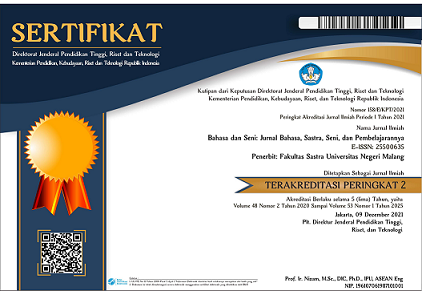Exploring Batik Semarangan as a medium to develop intercultural communication awareness and global competence
Abstract
People doing work from home are mostly depending on what the internet has to offer for communication. Because people want to make good use of the Internet for communication, such information is available in English as a global language. One of the advantages of having ready information in English is that local cultural products can now have better chances to compete globally with products from other cultures. One of those products is Indonesia’s Batik Semarangan, which is produced in Semarang, the capital city of Central Java. Through studying the motifs found in Batik Semarangan, an intercultural communication awareness of rich hybrid culture can be achieved. To ensure awareness, a group of English Department’s literature students was trained to do library and field research on Batik Semarangan. By applying Roland Barthes’ semiotics, students were encouraged to explore the hidden reasons for the unique choice of Batik Semarangan motifs. By doing this activity, not only were the students equipped to be more critical in researching local products but the lecturer has also helped preserve and elevate Batik as a traditional heritage that has global potentiality.
Keywords: Batik Semarang; cultural hybrid; traditional heritage; global competence; intercultural communication awareness
Menggali Batik Semarangan sebagai media untuk membentuk pengetahuan komunikasi antar budaya dan kompetensi global
Kebanyakan orang yang melakukan pekerjaan mereka dari rumah mengandalkan media komunikasi mereka dengan apa yang ditawarkan oleh internet. Karena orang ingin memanfaatkan internet dengan baik untuk komunikasi, maka banyak informasi tersedia dalam bahasa Inggris sebagai bahasa global. Salah satu keuntungan memiliki informasi dalam bahasa Inggris adalah produk budaya lokal sekarang dapat memiliki peluang yang lebih baik untuk bersaing secara global dengan produk dari budaya lain. Salah satunya adalah Batik Semarangan Indonesia yang diproduksi di Semarang, ibu kota Jawa Tengah. Melalui mempelajari motif yang ditemukan di Batik Semarangan, kesadaran komunikasi antarbudaya akan budaya hibrida yang kaya dapat dicapai. Untuk memastikan kesadaran tersebut, sekelompok mahasiswa Sastra Inggris dilatih untuk melakukan penelitian kepustakaan dan lapangan tentang Batik Semarangan. Dengan menerapkan semiotika Roland Barthes, mahasiswa didorong untuk mengeksplorasi alasan-alasan tersembunyi dari pemilihan motif batik Semarangan yang unik. Dengan melakukan kegiatan ini, siswa tidak hanya dibekali untuk lebih kritis dalam meneliti produk lokal tetapi dosen juga turut melestarikan dan mengangkat Batik sebagai warisan tradisional yang memiliki potensi global.
Kata kunci: Batik Semarangan; hibrida budaya; warisan tradisional; kompetensi global kesadaran komunikasi antarbudaya
Full Text:
PDFReferences
Angkawijaya, Y., Agustina, I. A., & Chuan, A. O. T. (2020). Batik as part of pop culture. SSRN Electronic Journal, DOI: 10.2139/ssrn.3807717. https://www.researchgate.net/publication/352839685_Batik_as_Part_of_Pop_Culture
Aryani, D. I., Pandanwangi, A., & Effendi, I. Z. (2020). Multiculturalism of mythological images in batik motifs. Advances in Social Science, Education and Humanities Research, vol. 560: Proceedings of the 2nd Annual Conference on Blended Learning, Educational Technology and Innovation (ACBLETI 2020). Atlantic Press.
Bennett, M.J. (January, 1998). Intercultural communication: A current perspective. In Milton J. Bennett (Ed.), Basic concepts of intercultural communication: Selected readings. Inter-cultural Press.
Chen, G. (2005). A model of global communication competence. Communication Studies Facul-ty Publications. University of Rhode Island. https://digitalcommons.uri.edu/cgi/viewcontent.cgi?article=1005&context=com_facpubs.
Flick, U. (2013). The SAGE handbook of qualitative data analysis. SAGE. https://www.semanticscholar.org/paper/The-SAGE-Handbook-of-Qualitative-Data-Analysis-Flick/91b0f30c29416cc057735e3181a626940f475bf7
Kraidy, M.M. (2005). Hybridity, or the cultural logic of globalization. Temple University Press. https://library.oapen.org/handle/20.500.12657/31581
Larasati, D. (2018). Globalisasi budaya dan identitas: Pengaruh dan eksistensi Hallyu (Korean Wave) versus westernisasi di Indonesia. Jurnal Hubungan Internasional, 11(1), 109-120
Marotta, V. “Cultural hybridity”. In The Blackwell encyclopedia of sociology, DOI: 10.1002/9781405165518.wbeos1616, https://www.researchgate.net/publication/352439615_Cultural_Hybridity
Maziyah, S. & Alamsyah. (2020). Natural motifs on Jepara batik products: Symbols of environmental awareness. E3S Web of Conferences 202. 07057. ICENIS 2020. https://doi.org/10.1051/e3sconf/202020207057
Mishra, S. K. (2016). Ecocriticism: A study of environmental issues in literature. BRICS Jour-nal of Educational Research, 6(4), 168–170.
Mohammad, N. (2017). Three waves of ecocriticism: An overview. IIUC Studies, 14(2), 55–70.
Newman, L. (2006). Nature and capitalism in Margaret Fuller’s Summer on the Lakes. https://www.academia.edu/4234033/Nature_and_Capitalism_in_Margaret_Fuller_s_Summer_on_the_Lakes.
Rahman, K. T. & Arif, M. Z. U. (2020). Working from home during the COVID-19 pandemic: Satisfaction, challenges, and productivity of employees. International Journal of Trade and Commerce-IIARTC, July-December 2020, 9(2), 282-294.
Roenne, A. (2016). Analysis of Ralph Waldo Emerson’s “Nature”. https://www.theodysseyonline.com/analysis-ralph-waldo-emersons-nature
Sharma, V. K. (2017). Thoreau’s ecocriticism: An improved means to unimproved ends, American Journal of Art and Design, 2(1), March 2017, pp. 24-29. doi: 10.11648/j.ajad.20170201.14
Smith, K. E. I. (2008). Hybrid identities: Theoretical examinations. In K. E. I Smith and P. Leavy (Eds.), Hybrid identities: Theoretical and empirical examination, (pp. 3-12). Brill.
Takagi, A. & Moeller, A. J. (2022). Developing critical cultural awareness in the ELT classroom. The Journal of Asia TEFL, 19(1), 247-256. http://dx.doi.org/10.18823/asiatefl.2022.19.1.16.247
Yuliati, D. (2010). Mengungkap sejarah dan motif Batik Semarangan. Paramita, 20(1), 11-20. https://doi.org/10.15294/paramita.v20i1.1055
DOI: http://dx.doi.org/10.17977/um015v51i12023p73
Refbacks
- There are currently no refbacks.

This work is licensed under a Creative Commons Attribution 4.0 International License.

Dear Sir/Madam
We appreciate your continued confidence and trust in Bahasa dan Seni: Jurnal Bahasa, Sastra, Seni, dan Pengajarannya (JBS). In order to enhance the service, readability, and quality of JBS publications, we will be transitioning to a new website, https://citeus.um.ac.id/jbs, in collaboration with Digital Commons (Elsevier) starting in July 2024.
Sincerely
Yusuf Hanafi
(Editor in chief)















2.png)